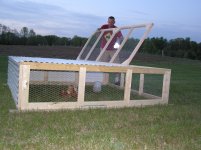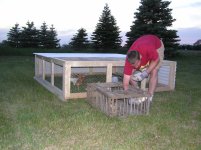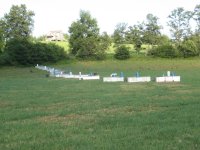So, here's the mid-season chicken tractor update....
The operation has gone really well as far as the chicken tenders (those who tend the chickens, not the chicken nugget variety) have managed. They have kept the field neat, and been there every day, twice a day to check on things. The chicken impact has been spread evenly across the field. Already in the wake of the pens, where they were more than a month ago, I can see the grass getting greener and heavy.
The worst problem has been the extremely wet weather early on. The chicken guys have to drive in and out to haul feed, water, and chickens. They replenish with new chicks and take out large birds for butchering on a weekly rotation now. The rains pushed back my 1st cutting 6 weeks. There is a photo here from yesterday--I think there are 18 pens going at the moment you can see there. They are getting moved from bottom left to top right in the picture.
There was water standing in part of this field, even 2 weeks after the bulk of the monsoon had quit. The grass was way tall for the guys and chicks to deal with, but I couldn't get it cut ahead of the pens for all the water. Had the season been normal, we would not have experienced this trouble, and I could have cut my first cutting well ahead of the pens.
Also, there were a couple of stuck vehicles and tire tracks, not what you like to see in your hayfield, but these guys couldn't have done much better at trying to be careful about getting to the pens. There just was no good way to deal with that much rain.
Now, I'm thinking it is still too nasty behind the pens to try for a second cutting. So, I think the truth is that to do this, you'd better get a 1st cutting before the chickens come, and forget about 2nd, or maybe even let them come in after 2nd, and give the winter for the post-chicken surface to weather to a safe hay making state. Of course, the chicken guys can't work to that schedule, they need to be running all season.
On the up side, I bet we'll see a dark green stripe wherever the pens have traveled next spring. I've got last year's soil samples to compare to post-chicken samples, so I'll share that data when it comes in.
So, it's not exactly a hay makers dream, but if you can do without part of your fields where this is going on for part of a season, it may be worth it in terms of fertilizer cost savings and soil building. I'll have to see how beneficial the benefits turn out to be.



